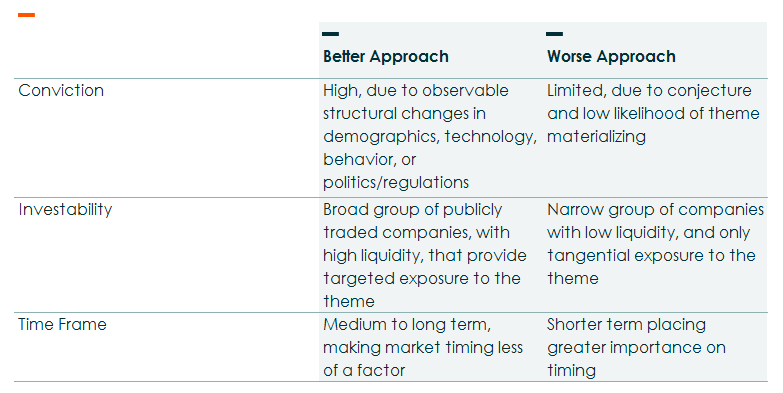What is Thematic Investing?
Thematic investing refers to the process of identifying powerful macro-level trends and the underlying investments that stand to benefit from the materialization of those trends. Many investors already apply principles of thematic investing, such as identifying investments that could benefit in a rising interest rate regime, in their portfolios. But thematic investing extends far beyond economic policies, and can potentially be most effective when used to identify opportunities in areas such as changing demographics, evolving consumer behaviors, innovative technologies, and the availability of natural resources.
“Thematic investing is about capitalizing on future trends. Its forward-looking nature stands in clear contrast to the more widely used market capitalization approach [which] assumes that past winners will continue to win out… Why is thematic investing a good idea? In a rapidly changing business environment, the winners will be those that anticipate trends and take advantage of new opportunities.1” – Towers Watson, “Thematic Investing”
Uses for Thematic Investing: Primarily a Long Term Growth Play
Investors who apply a thematic investment approach are often returns-focused, either seeking to beat a relative benchmark (e.g., the S&P 500) or an absolute return benchmark over the long term. According to a recent report from UBS, “Investors who are willing to follow the insights of such long-term themes over multiple business cycles can benefit from potential mispricing created by the typically shorter-term focus of financial markets.2”
Beyond serving merely as a growth play, themes can also be utilized to relate investing to an end-client, as some prefer making allocation decisions based on things they know and can observe. According to Merrill Lynch, three-quarters of US Millennials list long term thematic issues as one of their top three determining factors when making an investment decision3.
“Looking forward, we believe that thematic investing can outperform in the brave, new, post-QE world; that early, contrarian theme adopters can benefit from its low frequency investment style; and that capital flows are increasingly theme driven.4” – Merrill Lynch, “A Transforming World”
Some sophisticated institutional investors have also used thematic strategies as a form of hedging risk, such as a pension fund with high exposure to oil prices investing in companies in the renewable energy space, which could succeed at oil’s expense.
Keys to Success
Successfully implementing a thematic investment strategy requires correctly identifying structural shifts, finding companies with high exposure to those shifts, and timing the theme so as to enter early enough that earnings and forecasts have not fully priced in the theme’s potential. In a report on the rising usage of thematic investing among institutional investors, McKinsey & Company recommended that “Investors should assess the high-level attractiveness of the theme and make sure there are… companies whose businesses are heavily exposed to the theme…” An investor must then monitor the theme “over time to find the right entry (and exit) points.5”
In the table below, we list out what we believe are characteristics of better and worse approaches to thematic investing, based on conviction, investability, and time frame.

An Unconstrained Approach
A thematic approach differs from traditional portfolio construction in that it breaks out from the grid-like method of asset allocation. According to a whitepaper from RBC, “Thematic investing ignores geographical boundaries, style biases and market capitalization, and it transects traditional sector classifications. This provides investors with a distinctive strategic advantage: The ability to look across all geographies to identify emergent and potentially rewarding investment trends.6” Given thematic investing’s agnostic approach to geographies and sectors, it can have low correlations to other portfolio strategies, which can be particularly useful for investment managers seeking to diversify sources of growth.
ETFs & Thematic Investing
Many investors are already familiar with the inherent advantages of ETFs, including the typically lower costs of index-based investment strategies compared to actively managed funds, and the tax efficiency and transparency ETFs versus traditional Mutual Funds. Within the context of thematic investing these advantages still play a large role.
An additional key benefit to using thematic ETFs is the ability to access dozens of companies around the world with a single trade. Traditionally, thematic investing has been limited to more sophisticated institutional investors due to the research required to pinpoint companies with high exposure to a theme and the need to access a variety of international markets for themes that are global in nature. Thematic ETFs track indexes that take care of the security selection part of the process and can provide access to a broad set of companies around the world with exposure to a particular theme.
 Global X Research Team
Global X Research Team